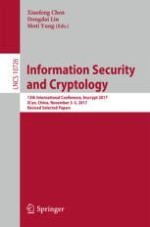2018 | Buch
Information Security and Cryptology
13th International Conference, Inscrypt 2017, Xi'an, China, November 3–5, 2017, Revised Selected Papers
herausgegeben von: Xiaofeng Chen, Dongdai Lin, Moti Yung
Verlag: Springer International Publishing
Buchreihe : Lecture Notes in Computer Science
